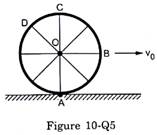Consider a wheel of a bicycle rolling on a level road at a linear speed ![]() (figure 10-Q5).
(figure 10-Q5).

Looking into fig, we can say that points B, C and D cannot have equal speeds, because the wheel is not
in pure rotation about O. Hence, option (B) becomes false.
It can be seen that diameter of the wheel, AC is instantaneously in pure rotation about the point A. So, the speed of the particle A is zero. Option (A) is true

The point B has one more component of velocity downward, hence its total velocity > velocity of O.
Hence option (D) also correct.
Also, speed of point C remains ![]() since its moving along the axis of wheel.
since its moving along the axis of wheel.
1